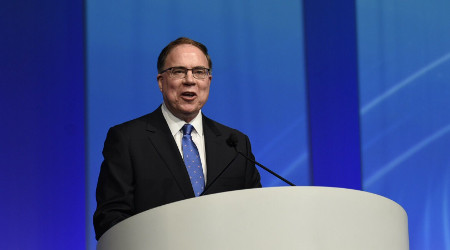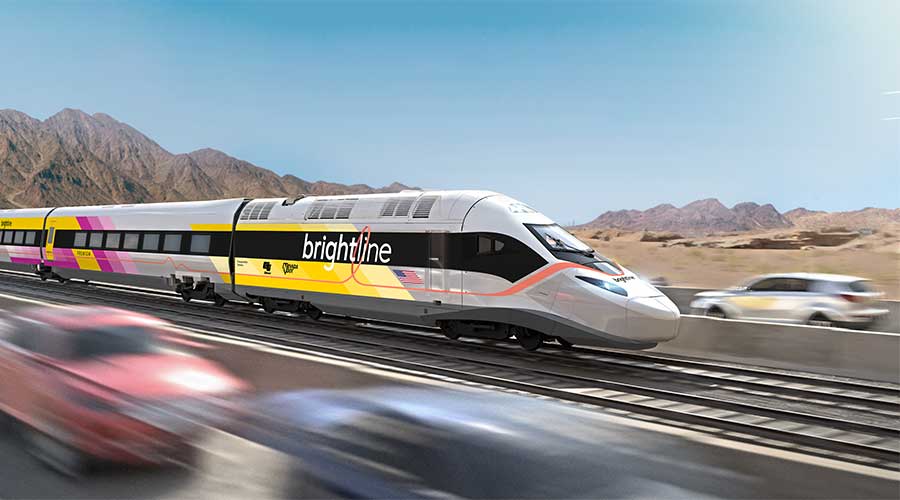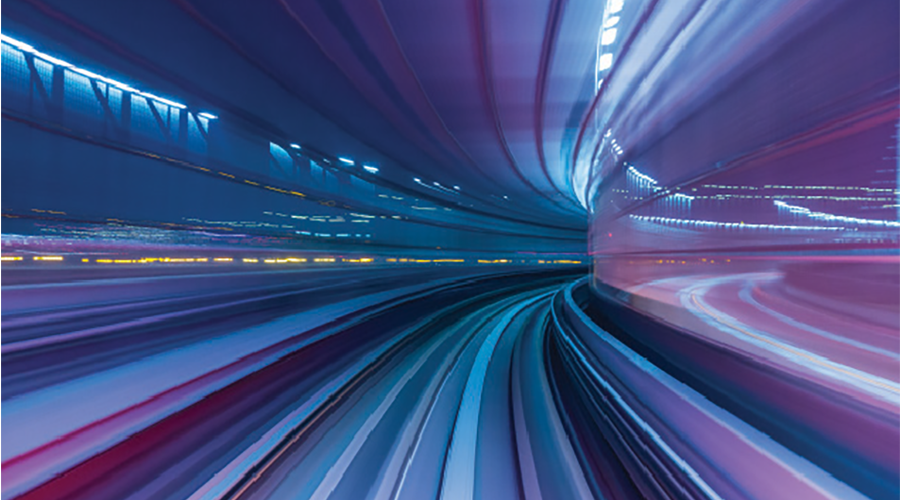Stay updated on news, articles and information for the rail industry
December 2017
Rail News: Passenger Rail
Outlook 2018: APTA leader forecasts great challenges, greater opportunities for transit

Compiled by Daniel Niepow, Associate Editor
It's been a year of mixed messages for public transit leaders. For instance, although President Donald Trump has pledged to unveil a $1 trillion infrastructure package, he's also proposed deep cuts to Amtrak's services and transit grant programs.
Looking into the new year, things likely won't be getting any easier for transit execs in 2018. Funding remains a perennial issue, and ride-sharing companies like Lyft and Uber pose an ongoing threat to ridership.
Still, American Public Transportation Association (APTA) Senior Adviser Richard White believes 2018 holds a wealth of opportunities for transit agencies. For one, agencies can begin exploring collaborative partnerships with ride-sharing services instead of viewing them as competitors.
"Traditional public transit operators will need to become mobility managers in the broadest sense," explains White, who previously served as APTA's acting president and chief executive officer. "That transformation needs to begin now, and we're already seeing it happen."
Below, White shares his thoughts on some other big-picture transit industry issues that likely will be crucial ones in the coming year.
What are some of the biggest challenges transit agencies will face in 2018?
White: We are entering a time of profound transformational change in the public transportation sector, the likes of which we have not experienced since the advent of the automobile more than 100 years ago. Today, the future of public transit is being shaped by non-stop technological advances, the public's shifting preferences and lifestyle choices, and the emergence of new service providers. The challenges are great, but the opportunities are even greater.
In the short term – the coming 12 months – our industry has two simultaneous challenges: maintain, repair and replace aging infrastructure; and meet the increasing expectations of customers who demand new services, state-of-the-art amenities, greater convenience and solid reliability.
Under the best of circumstances, this dual mission would be difficult. What makes it that much more daunting — and urgent — is the unprecedented $95 billion backlog in state of good repair (SOGR)/modernization work needed just to bring our current public transit assets into acceptable condition. This number grows every day and does not include the additional resources to maintain these improvements. This problem grows bigger every year as the annual capital spend for public transportation is only approximately $20 billion, 43 percent of which is federal dollars.
One of the more formidable infrastructure issues facing many public transit agencies today is the statutory requirement to install positive train control (PTC) equipment by the end of 2018. This important safety improvement is underway in rail systems across the country, but there are complex technical and financial obstacles that require considerable time and resources to address.
Another pressing safety issue is the need for 30 states and Puerto Rico to obtain federal certification of their transit-rail State Safety Oversight programs by April 15, 2019. Only three states (Minnesota, Ohio and Utah) have been certified thus far. If a state fails to meet the deadline, the Federal Transit Administration is prohibited by law from awarding any new federal funds to public transportation agencies within the state until certification is achieved.
Aging infrastructure not only impacts safety and security; it also can create service delays that erode public trust as well as ridership numbers. And even a small dip in riders adversely affects revenue, which puts more pressure on transit systems' ability both to modernize and expand service.
A second challenge for public transportation systems in 2018 is the growth of ride-sharing companies. Trends all point to a future with more transportation choices. Communities of every size and character are choosing to create new options for citizens rather than continue to be automobile dependent.
With ride-sharing companies such as Uber now in the transportation mix, the issue of time competitiveness – that is, how fast one can travel from point A to point B – is an increasingly key factor in whether people choose public transit or an alternative travel solution. And there is evidence that public transit ridership has fluctuated in some places where ride sharing is growing in popularity.
Finally, predictable, consistent, long-term funding is the third challenge not just for this year but also into the future. Like roads, bridges and highways, public transportation is supported by local, state, and federal governments. On a national level, fare revenue only pays for about one-third of operating expenses. A report by APTA and the American Association of State Highway and Transportation Officials found that the annual capital investment needed over a six-year period to maintain public transportation service in the United States jumped from $17.7 billion in 2013 to $43 billion in 2015. This is the annual spend amount after assuming that the $95 billion SOGR backlog is addressed. This underscores the importance of a local-state-federal partnership to maintain, modernize and expand public transit in the United States.
Unfortunately, there are several troubling signs on the horizon:
- Despite the long history of beneficial federal support for public transit, the Trump administration has embraced a policy that makes public transportation a local and state issue, not a federal responsibility. As a result, the president's proposed budgets have sought to reduce, phase out or eliminate federal funding for transit programs and grants, including Capital Investment Grants, TIGER grants, Amtrak long-distance routes and inner-city rail programs. To date, Congress has resisted most, but not all these cuts. And another budget battle — and fundamental policy debate — will occur in 2018.
- The Highway Trust Fund will be insolvent by 2021. Without immediate action, the infrastructure backlog will grow and our surface transportation systems will continue to decline.
- The FAST Act expires on Sept. 30, 2020. That may sound like a long time from now, but it often takes years for Congress to approve complex, multi-year funding bills. The FAST Act was the first long-term surface transportation authorization enacted in 10 years, since the passage of SAFETEA-LU in 2005.
How can transit agencies prepare to take on those challenges?
White: To meet the short-term challenges above, our industry must take the following initiatives:
- Mount an expansive, aggressive campaign to make funding for public transportation a national economic and a national security priority. This is a cause that goes beyond state-of-good-repair concerns; it's about investing in our long-term competitiveness and growth, and it demands participation from every industry. We must ensure sufficient federal funding, not just incentives, is included in any infrastructure investment initiative from the Trump administration or Congress in 2018.
This issue ought to have broad support. There is unmistakable evidence that the public wants more public transportation. Voters from diverse locales across the United States approved $170 billion in new investment for public transit in 2016. Most of those investments were in rail transit systems. In fact, in the past five years, Americans passed more than 70 percent of ballot initiatives that included funding for public transportation.
Local communities and multinational businesses should get involved as well, because investment in public transit creates jobs and spurs economic development. Almost nine out of every 10 trips on public transit directly benefits a local economy — by getting people to a job or event where they earn or spend money. And for every $1 invested in public transportation, $4 in economic activity is returned to the community.
Proximity to good public transportation options has been a deciding factor in many companies' relocation decisions because it guarantees access to high-skilled workers. Amazon has publicized its search for a city suitable to establish a second headquarters, and corporations such as Marriott, McDonald's, State Farm, Motorola, Verizon and General Electric have decided to locate or expand near public transportation services.
Residential and commercial property values are higher around public transit facilities. For example, hotels in cities with direct rail access to airports earn 11 percent more revenue per room. Rail cities also attract more revenue-generating events and conventions than do non-rail cities. - Forge new partnerships with new public and private service providers.
In the emerging new mobility ecosystem, public transportation will become the backbone of a multimodal system involving many different partners and interests.
Traditional public transit operators will need to become mobility managers in the broadest sense. That transformation needs to begin now, and we're already seeing it happen.
For example, many public transit agencies are finding new efficiencies — and new riders — through partnerships with ride-sharing companies for first-mile/last-mile connections, or for demand-response paratransit services. Uber, VIA, Zipcar and Motivate are among the organizations that have joined APTA to strengthen this synergy.
Such innovation and entrepreneurship, as well as new public and private partnerships, are the building blocks for our transportation systems of tomorrow. The long-term trend is that public transportation ridership has exceeded population growth and growth in vehicle-miles-traveled over the past two decades. - Build the foundation for the next FAST Act — and a new long-term, sustainable funding mechanism.
Our industry has less than 33 months to craft and pass an innovative piece of legislation that will propel public transportation into the middle of this century.
Our future success depends on how we write the chapter that follows the FAST Act and how well it prepares public transit agencies for a new mobility paradigm shaped by new entrepreneurs, innovative financing, autonomous vehicles and changing business models. We must get it right and we need to begin the process now.
[Editor's note: This story was updated on Jan. 3, 2018.]


 LRW Honors Amtrak’s Acheson As Railway Woman Of The Year
LRW Honors Amtrak’s Acheson As Railway Woman Of The Year
 From Editor-In-Chief Foran: Of Gender Equity And Inclusion
From Editor-In-Chief Foran: Of Gender Equity And Inclusion
 Spotlight On Some Of Today’s Rail Safety Products
Spotlight On Some Of Today’s Rail Safety Products
 Women of Influence in Rail eBook
Women of Influence in Rail eBook
 railPrime
railPrime







